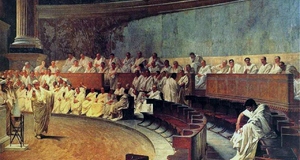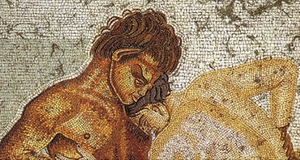Lucius Sergius Catalina: Villain or Victim? The Famed Cicero as a Violent Aggressor
By
2012, Vol. 4 No. 08 | pg. 2/2 | « Within the novel, which follows an imagined protagonist named Gordianus through his familial and political exploits (that happen, in this case, to throw him in the path of this infamous man) Catilina is, by far, the most interesting and dynamic character. He is not perfect, by any means; he is lascivious and lustful, having longstanding affairs with many young men (something quite accepted at the time, and an elaboration on Saylor’s part regarding the many rumors persisting about Catilina’s relationships) and even admitted, in confidence, to having sex with a Vestal Virgin; a real historical scandal of which he had been acquitted due to lack of evidence. He is impossibly handsome and charismatic, his fashion sense setting the standard for all others who wished to be like him, a description which acutely recalls modern habits of admiring a hero. We tend to knock these very same heroes off of their pedestals, even delighting in their fall. Not much may have been different in ancient Rome. Catilina almost immediately puts Gordianus at ease when he arrives at the house to stay during his political sojourn. The reader is terrified, along with Gordianus, waiting for this fearsome man to arrive, one who had apparently engaged in so many violent and unforgivable acts. It is certainly a shock when Catilina finally does enter into the story, proving friendly and cooperative; it always felt a shame when he left the narrative. Saylor surely felt Catilina to be a victim, and Cicero is written as a grand schemer, actively orchestrating Catilina’s fate. Gordianus and his son even switch their loyalties from Cicero – who had even liked Gordianus, and done him a great favor in the past – and join Catilina in his last, and losing, battle at Pistoria.One of the greatest problems for many people when they are presented with the possibility of Catilina’s innocence remains the atrocity of the crimes which he is said to have committed. Could they all really have been fabricated? The answer, while nobody actually knows for sure, is still a resounding yes. He was said to have engaged in an earlier conspiracy, for example, in 66 BCE, one to – again – assassinate the then-consuls. Sallust and Cicero, along with others, accepted this as a perfect truth, but there is one glaring problem: no evidence exists to prove the assertion. Erich S. Gruen, in his article Notes on the First Catilinian Conspiracy, writes: “Logic compels a devastatingly obvious conclusion. The rival candidates in 66 were simply contesting for the consulship. Like all consular elections, it was a matter of ambition and dignitas. Perhaps there was a little more bribery, perhaps a little more bitterness than usual… There is no need to imagine murky plots… – much less conspiracy, murder, or revolution.”15 Modern historians have gone in all different directions when deciding upon their own theories. Some reject this first conspiracy altogether due to lack of evidence, some believe it was simply a rumor, some pass it over, unwilling to muck through the contradictory evidence, and others attempt to reconstruct the narrative and defend Catilina’s guilt, reconciling the many inconsistencies.16 The only conclusion, therefore, is that we do not know – and Catilina cannot be convicted based on hearsay. He may have guilty, to be sure, but there is a great chance that he was not, and was instead the victim of an earlier plot to frame him. Cicero was a convincing man, after all; a master of words and of speech who delighted in delivering his many addresses to the Roman assembly. In an oration unrelated to the conspiracy (but that nonetheless demonstrates his vigor for public life), he begins by stating: “To face the crowded ranks of your Assembly has always given me a very special satisfaction. No place, it seems to me, lends greater dignity to the proposal of a motion, no environment is more impressive for a speech. You provide here, citizens, a road to fame which has always been wide open to every man of merit.”17 A man this fervent in his love for staying in the public eye would probably do almost anything to keep his enviable position, taking advantage of his great skill to remove any possible threats to his name. Other crimes were thrown at Catilina as well. He was accused of profiting from Sulla’s dictatorship, killing his own brother-in-law, murdering the praetor Gratidanus, defiling a Vestal Virgin, and of killing his son to please his new wife, who allegedly did not want to marry into a family that already had an heir. There are no true explanations to flesh out these crimes, the historical record simply proving that Catilina was always acquitted, but Saylor provides very interesting accounts – according to the fictionalized Catilina – of what may have happened. We cannot deem these quotes to be factual, but they certainly add color to the argument, assisting in propelling it forward. Saylor did his research, and these assertions can be taken similarly to any other scholarly argument. As has already been discussed, Catilina was likely guilty of extortion, and of profiting under Sulla. To this, Saylor’s Catilina responds “Many others did the same. But I never murdered for gain or used the proscriptions to get away with murder.”18 In other words, how different was he from the many others who took advantage of their stance under the dictatorship? Doing so may have been wrong, but it was hardly an attack against Rome itself. Saylor also writes Catilina as guilty of sleeping with the Vestal Virgin, a horrible crime punishable by death – it is instead a funny anecdote of consensual sex, and not an isolated incident among Rome’s elite, who were often defended by high-ranking friends on court. Again, this does not make Catilina evil, but almost adds to his personality. Not everyone during that time was especially pious. Defenses against the more serious crimes of murder, as written by Saylor, are more affecting. The fictionalized Catilina brings up his slain brother-in-law, insisting “As if I would have wanted to see my own sister dishonored and disinherited!”19 He seems to mourn the dead Gratidanus, apparently horrifically killed by a mob, and becomes the most emotional about his dead son: “If he had lived, today he would be a man, at my side in my struggles, a comfort and an inspiration to me. He died from fever, yet my enemies call it poison, and they use the tragedy of his death as a sordid weapon against me.”20 These quotes, though not “real,” provide a human element to Catalina that may well have been entirely true. He suffered great losses in his family, which were instantly looked at as murder. Is not it more likely that he was misfortunate, already a victim even before the conspiracy? He was a strong man, but he was no match for the verbal prowess and power of Cicero’s many subsequent speeches condemning his nature, speeches that riled up the populace and forced Catilina to leave Rome and flee to an army – now forced to be the very Roman invader he was first accused of being. Cicero’s voice would have been booming in the Assembly, yelling with impassioned anger against his enemy: “How long, Catiline, will you abuse our patience?” the first speech begins. “How long shall that fury of yours hector down even us too? To what bounds shall your unbridled audaciousness fly out? […] Are you not aware that your plots are discovered? […] Long since, Catiline, thou shouldst have been led by the consul’s order to execution; upon thine own head should have been turned that destruction which thou has been so long contriving against all of us.”21 How could Catilina truly have defended himself? In a room convinced of your guilt, explicating details and intricacies – especially when your past truly is sordid – is a losing battle. Perhaps it is not important to dwell on the guilt or innocence of Lucius Sergius Catilina. The truth will never magically present itself to us, and his reputation will always be contested. We tend to forget, however, that he was a real person, one who – whether or not he was a conspirator – suffered personal tragedies and eventually died young in a hopeless battle. Historian K.H. Waters feels that the convention of forming a high opinion of Cicero has only further damaged Catilina’s reputation. “Only in the fertile imagination of Cicero himself could many of the alleged facts have had their origin,” he states – and we believe what Cicero says.22 Before presenting his argument, Waters states his purpose for adding to the already voluminous body of work devoted to the Catilinian Conspiracy, similar to my own reason: “I hope, by calling attention to the conspicuous implausibilities in the accepted story, to contribute to a reduction in the emphasis laid upon the Catilinian affair in the study of Roman history and perhaps even of literature.”23 Hopefully, digging at the truth will help to ease Catilina’s two thousand-year-old burden. ReferencesCatilina, Lucius Sergius. Catiline, Clodius, and Tiberius Followed by Necker and Calonne, trans. Edward Spencer Beesly. Oxford: University Press, 2006. Crispus, Gaius Sallustius. The Jugurthine War/ The Conspiracy of Catiline. New York: Penguin, 1963. Crispus, Gaius Sallustius and Marcus Tullius Cicero. The Catiline and Jugurthine Wars of Sallust: Together With the Four Orations of Cicero Against Catiline, trans. Graduate of the University of Oxford. Montana: Kessinger Publishing, 2010. Gruen, Erich S. “Notes on the "First Catilinian Conspiracy." Classical Philology, Vol. 64, No. 1 (1969): 20-24. Jones, Francis L. “The First Conspiracy of Catiline.” The Classical Journal, Vol. 34, No. 7 (1939): 410-422. Phillips, E.J. “Catiline's Conspiracy.” Historia: Zeitschrift für Alte Geschichte, Vol. 25, No. 4 (1976): 441-448. Saylor, Steven. Catilina’s Riddle. New York: St. Martin’s Minotaur, 1993. Waters, K.H. “Cicero, Sallust and Catiline.” Historia: Zeitschrift für Alte Geschichte, Vol. 19, No. 2 (1970):195-215. Yavetz, Z. “The Failure of Catiline’s Conspiracy.” Historia: Zeitschrift für Alte Vol. 12, No. 4 (1963): 485-499. Endnotes
Suggested Reading from Inquiries Journal
Inquiries Journal provides undergraduate and graduate students around the world a platform for the wide dissemination of academic work over a range of core disciplines. Representing the work of students from hundreds of institutions around the globe, Inquiries Journal's large database of academic articles is completely free. Learn more | Blog | Submit Latest in History |


















